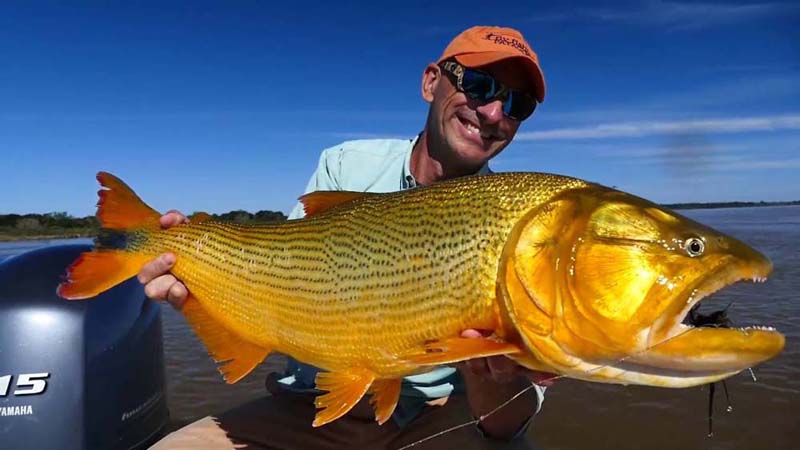
Ruben Martin, one of the world’s most accomplished fly tyers and one of the most innovative, will be producing weekly videos on how to tie small, classic trout flies on tubes and larger ones like this ‘Predator.’ Martin is the most noted international source of tying ‘small’ tube flies. Adding his channel to your video library will improve your fly fishing enjoyment, and if you tie a good bet, you’ll become addicted to tubes and improved catch stats.
Powerful, aerial acrobat, aggressive, and beautiful, the Golden Dorado has it all
By Ruben Martin
Although my friend Skip Clement has requested me some notes about the tube fly adapted into trout fishing, having travelled to the frontiers of the nymphs, dry flies and small streamers (something I have been experimenting for years), I cannot let the opportunity pass and not show you an adaptation for tube flies that we have made for the emblem fish of Argentina, which is, The Golden Dorado, or as we call it in my country, “River Tiger.”
Fishing for Golden Dorado is one of the most thrilling fishing experiences; apart from its size and fierceness, it’s also a fish that can be a big challenge because it can become very complex, especially if we are looking for adult sizes to have as trophies.
The Golden Dorado possesses a terrifying jaw, capable of ripping in half a 4-or 5-kg fish without breaking a sweat.
Now imagine how our fly will do in those circumstances – it’s why flies made for Dorado usually last only a short time. With only a few bites, or sometimes even a single one, our fly can get destroyed.

International Game Fish Association [IGFA] World Record Dorado [Salminus brasiliensis] on a fly:
16-pound test, 48 lbs, Uruguay River, Concordia, Argentina, 18 January 2006, Raz Reid. Photo credit Fly Fishing Patagonia [Argentina fishing and hunting outfitters]. Photo credit Fly Fishing Patagonia [Argentina fishing and hunting outfitters]. NOTE 1: The Golden Dorado image shown above is not the [IGFA] world record fish. NOTE 2: All of the IGFA world records [Conventional Tackle, Tippet Class, Junior & Small Fry] for the Golden Dorado [Salminus brasiliensis] were caught in Argentina.
There’s also a very important third factor in this case, and it is that for Dorado fishing, you must use very strong and big hooks, up to 6/0, and these hooks used in “long shanks” would end up being too heavy to cast, it is because of this that “short shank” hooks are chosen. However, the use of short hooks in flies as big as the ones utilized in Dorado fishing can also represent a problem, which is that in a fly that big, the bend of the hook is left positioned too far in front of the fly, which generates failed bites.
In tube flies, the hook is tied over the tube, and the hook is left further back than it would be when using the conventional method; this betters the hooking of the fly when the fish bites.
We hope you like this idea and can apply it when catching big fish, such as the pike, musky, bass, and some saltwater fish.


